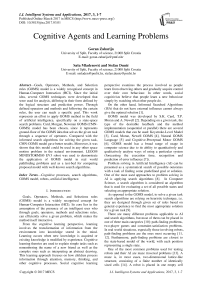Cognitive Agents and Learning Problems
Автор: Goran Zaharija, Saša Mladenović, Stefan Dunić
Журнал: International Journal of Intelligent Systems and Applications(IJISA) @ijisa
Статья в выпуске: 3 vol.9, 2017 года.
Бесплатный доступ
Goals, Operators, Methods, and Selection rules (GOMS) model is a widely recognised concept in Human-Computer Interaction (HCI). Since the initial idea, several GOMS techniques were developed that were used for analysis, differing in their form defined by the logical structure and prediction power. Through defined operators and methods and following the certain rules, the user can reach a specific goal. This work represents an effort to apply GOMS method in the field of artificial intelligence, specifically on a state-space search problems. Card, Morgan, Newman GOMS (CMN-GOMS) model has been chosen, since it represents ground-floor of the GOMS idea that solves the given task through a sequence of operators. Compared with the informed search algorithms for solving the given task, CMN-GOMS model gave better results. Moreover, it was shown that this model could be used in any other space motion problem in the natural environment. LEGO® MINDSTORMS® EV3 robot was used to demonstrate the application of GOMS model in real world pathfinding problems and as a test-bed for comparing proposed model with well-known search algorithms.
Cognitive processes, search algorithms, GOMS model, robots, artificial intelligence
Короткий адрес: https://sciup.org/15010907
IDR: 15010907
Список литературы Cognitive Agents and Learning Problems
- Gendreau, Michel, and Jean-Yves Potvin. "Tabu search." Search methodologies. Springer US, 2014. 243-263.
- Tauber, M. G., & Ackermann, D. (Eds.). (2013). Mental models and human-computer interaction (Vol. 7). Elsevier
- Rice, Andrew D., and Jonathan W. Lartigue. "Touch-level model (TLM): evolving KLM-GOMS for touchscreen and mobile devices. "Proceedings of the 2014 ACM Southeast Regional Conference. ACM, 2014.
- Guo, Hua, Diem Tran, and David H. Laidlaw. "Incorporating GOMS analysis into the design of an EEG data visual analysis tool. "Visual Analytics Science and Technology (VAST), 2012 IEEE Conference on. IEEE, 2012.
- Ritter, Frank E., Gordon D. Baxter, and Elizabeth F. Churchill. "Methodology I: Task Analysis. "Foundations for Designing User-Centered Systems. Springer London, 2014. 309-333.
- Patton, E. W., Gra, W. D., & John, B. E. (2012, September). Automated CPM-GOMS modeling from human data. In Proceedings of the Human Factors and Ergonomics Society Annual Meeting (Vol. 56, No. 1, pp. 1005-1009). SAGE Publications.
- Ramkumar, A., Stappers, P. J., Niessen, W. J., Adebahr, S., Schimek-Jasch, T., Nestle, U., & Song, Y. (2016). Using GOMS and NASA-TLX to Evaluate Human-Computer Interaction Process in Interactive Segmentation. International Journal of Human–Computer Interaction, 1-12.
- Landau, R. H., PÃ, M. J., & Bordeianu, C. C. (2015). Computational Physics: Problem Solving with Python. John Wiley & Sons.
- Hansson, Othar, and Andy Mayer. "Heuristic search as evidential reasoning." arXiv preprint arXiv: 1304. 1509 (2013).
- Korf, R. E. (2010). Artificial intelligence search algorithms (pp. 22-22). Chapman & Hall/CRC.
- Nahm, Y. E., & Ishikawa, H. (2005). A hybrid multi-agent system architecture for enterprise integration using computer networks. Robotics and Computer-Integrated Manufacturing, 21(3), 217-234.
- Ni, Z., & He, H. (2013). Heuristic dynamic programming with internal goal representation. Soft computing, 17(11), 2101-2108.
- Yadav, S., Verma, K. K., & Mahanta, S. (2012). The Maze problem solved by Micro mouse. International Journal of Engineering and Advanced Technology (IJEAT) ISSN, 2249-8958.
- Foltin, M. (2011). Automated Maze Generation and Human Interaction. Brno: Masaryk University Faculty Of Informatics.
- LEGO® MINDSTORMS® EV3, Manual, http://www.lego.com/en-us/mindstorms/, 26. 08. 2016.
- Woeginger Gerhard J. "Space and time complexity of exact algorithms: Some open problems." International Workshop on Parameterized and Exact Computation. Springer Berlin Heidelberg, 2004.
- John, B. E. and Kieras, D. E. The GOMS Family of User Interface Analysis Techniques: Comparison and Contrast, ACM Transactions on Computer-Human Interaction, 3 (1996), 320-351.
- Argall, Brenna D., et al. "A survey of robot learning from demonstration." Robotics and autonomous systems 57.5 (2009): 469-483.
- Ai-bing, N. I. N. G., Liang, M. A., & Xiao-hua, X. (2007, August). Solving degree-constrained minimum spanning tree with a new algorithm. In 2007 International Conference on Management Science and Engineering (pp. 381-386). IEEE.
- Kotthoff, L. (2014). Algorithm selection for combinatorial search problems: A survey. AI Magazine, 35(3), 48-60.
- Dechter, R. and Pearl, J. Generalized best-first search strategies and the optimality of A*, Journal of the ACM, 32 (1985), 505-536.
- Pearl, J. Heuristics: Intelligent Search Strategies for Computer Problem Solving. Addison-Wesley, Reading, Mass., 1984.
- Liu, Xiang, and Daoxiong Gong. "A comparative study of A-star algorithms for search and rescue in perfect maze." Electric Information and Control Engineering (ICEICE), 2011 International Conference on. IEEE, 2011
- Hanks, Steve, Martha E. Pollack, and Paul R. Cohen. "Benchmarks, test beds, controlled experimentation, and the design of agent architectures." AI magazine14.4 (1993): 17
- Zille, H., & Mostaghim, S. (2015, May). Properties of scalable distance minimization problems using the Manhattan metric. In 2015 IEEE Congress on Evolutionary Computation (CEC) (pp. 2875-2882). IEEE.
- Min, X., Xu, X., & Wang, Z. (2014, June). Combining von Neumann neighborhood topology with approximate-mapping local search for ABC-based service composition. In Services Computing (SCC), 2014 IEEE International Conference on (pp. 187-194). IEEE.
- Russell, S. J., Norvig, P., Canny, J. F., Malik, J. M., & Edwards, D. D. (2003). Artificial intelligence: a modern approach (Vol. 2). Upper Saddle River: Prentice hall.
- Seraji Homayoun, and Ayanna Howard. "Behavior-based robot navigation on challenging terrain: A fuzzy logic approach." IEEE Transactions on Robotics and Automation 18.3 (2002): 308-321.


